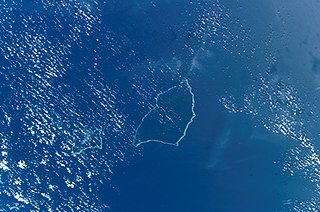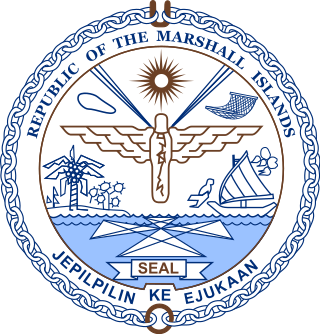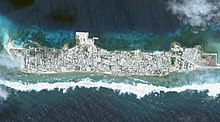
The Marshall Islands, officially the Republic of the Marshall Islands, is an island country west of the International Date Line and north of the equator in the Micronesia region of the Northwestern Pacific Ocean.

The Marshall Islands consist of two archipelagic island chains of 30 atolls and 1,152 islands, which form two parallel groups—the "Ratak" (sunrise) chain and the "Ralik" (sunset) chain. The Marshalls are located in the North Pacific Ocean and share maritime boundaries with Micronesia and Kiribati. Two-thirds of the nation's population lives in the capital of Majuro and the settlement of Ebeye. The outer islands are sparsely populated due to lack of employment opportunities and economic development.
Austronesian settlers arrived in the Marshall Islands in the 2nd millennium BC, but there are no historical or oral records of that period. Over time, the Marshallese people learned to navigate over long ocean distances by walap canoe using traditional stick charts.

Wotje Atoll is a coral atoll of 75 islands in the Pacific Ocean, and forms a legislative district of the Ratak Chain of the Marshall Islands.

The Maloelap Atoll is a coral atoll of 71 islands in the Pacific Ocean, and forms a legislative district of the Ratak Chain of the Marshall Islands. Its land area is only 9.8 square kilometers (3.8 sq mi), but that encloses a lagoon of 972 square kilometers (375 sq mi). It is located 18 kilometers (11 mi) north of the atoll of Aur. The population of the atoll was 395 at the 2021 census.

Likiep Atoll is a coral atoll of 65 islands in the Pacific Ocean, and forms a legislative district of the Ratak Chain of the Marshall Islands. It is approximately 55 kilometers (34 mi) northwest of Wotje. Its total land area is only 10.26 square kilometers (3.96 sq mi), but that encloses a deep central lagoon of 424 square kilometers (164 sq mi). Likiep Atoll also possesses the Marshall Islands' highest point, an unnamed knoll 10 meters (33 ft) above sea level. The population of Likiep Atoll was 228 in 2021.
Iroijlaplap are the traditional paramount chiefs in the Marshall Islands. Ordinary chiefs bear the title of Iroij ; -ļapļap is a superlative suffix.

The government of the Marshall Islands operates under a mixed parliamentary-presidential system as set forth in its Constitution. Elections are held every four years in universal suffrage, with each of the 24 constituencies electing one or more representatives (senators) to the lower house of RMI's unicameral legislature, the Nitijela. The President, who is head of state as well as head of government, is elected by the 33 senators of the Nitijela. Four of the five Marshallese presidents who have been elected since the Constitution was adopted in 1979 have been traditional paramount chiefs.

The following is an alphabetical list of topics related to the Marshall Islands.
Japanese settlement in the Marshall Islands was spurred on by Japanese trade in the Pacific region. The first Japanese explorers arrived in the Marshall Islands in the late 19th century, although permanent settlements were not established until the 1920s. As compared to other Micronesian islands in the South Seas Mandate, there were fewer Japanese who settled in the islands. After the Japanese surrender in 1945, the Japanese populace were repatriated to Japan, although people of mixed Japanese–Marshallese heritage remained behind. They form a sizeable minority in the Marshall Islands' populace, and are well represented in the corporate, public and political sectors in the country.

Climate change is particularly threatening for the long-term habitability of the island country of Tuvalu, which has a land area of only 26 square kilometres (10 sq mi) and an average elevation of less than 2 metres (6.6 ft) above sea level, with the highest point of Niulakita being about 4.6 metres (15 ft) above sea level. Potential threats to the country due to climate change include rising sea levels, increasingly severe tropical cyclones, high temperatures, and drought. King tides can combine with storm surges and the rising sea level to inundate the low lying atolls.
Anjua Loeak was one of the Iroijlaplap of Ailinglaplap, and one of four paramount chiefs in the Ralik Chain. Loeak shared his domain with the Iroijlaplap of Kwajalein, formerly Imata Kabua.

Iroijlaplap Christopher Jorebon Loeak is a Marshallese politician who was the President of the Marshall Islands from 2012 to 2016. He was elected by parliament as President in January 2012, following the 2011 general election.
Giff Johnson is a Marshall Islands-based editor and journalist. He is also the author of the self-published book Don't Ever Whisper, which tells of his late wife Darlene Keju's fight to share the Marshall Islanders plight with the rest of the world. In 2013, he was interviewed by ABC Radio presenter Geraldine Coutts in relation to the book.

David Kabua is a Marshallese politician who served as President of the Marshall Islands from 2020 to 2024. He has represented Wotho Atoll in the Legislature of the Marshall Islands since 2008 and served terms as Minister of Health and Internal Affairs.

Hilda Cathy Heine is a Marshallese educator and politician. She has served as the president of the Marshall Islands since 2024, having previously served from 2016 to 2020. Heine was the first woman to lead any sovereign country in Micronesia and the first person from the Marshall Islands to earn a doctorate. Prior to entering politics, she worked as a teacher and counselor at Marshall Islands High School and then as a women's rights activist with her organization Women United Together Marshall Islands.

Delap-Uliga-Djarrit is an urban area in Majuro, the capital and the largest city of the Marshall Islands, with 15,846 people out of Majuro's 23,676. It consists of the districts of Delap, Uliga, and Djarrit. DUD is located on the eastern end of Majuro Atoll. Marshallese government buildings are situated in DUD.

Casten Ned Nemra is a Marshallese politician who was President of the Marshall Islands for 17 days in January 2016. He was elected by the Nitijeļā (Parliament) as President in January 2016, following the 2015 general election, narrowly defeating Senator Alvin Jacklick, a seven-term member of Parliament, by a 17–16 vote. He was the youngest person to hold the job and the second commoner. He was ousted by a vote of no confidence after just two weeks in office by the opposition for jumping ship and joining Iroij Mike Kabua's Aelon Kein Ad party along with Senators Dennis Momotaro and Daisy-Alik Momotaro.

The effects of climate change on small island countries are affecting people in coastal areas through sea level rise, increasing heavy rain events, tropical cyclones and storm surges. These effects of climate change threaten the existence of many island countries, their peoples and cultures. They also alter ecosystems and natural environments in those countries. Small island developing states (SIDS) are a heterogenous group of countries but many of them are particularly at risk to climate change. Those countries have been quite vocal in calling attention to the challenges they face from climate change. For example, the Maldives and nations of the Caribbean and Pacific Islands are already experiencing considerable impacts of climate change. It is critical for them to implement climate change adaptation measures fast.

India–Marshall Islands relations are the bilateral relations between India and the Marshall Islands. The respective embassies of the two countries in Tokyo, Japan are concurrently accredited to each other. Marshall Islands maintains an Honorary Consulate in New Delhi.
















